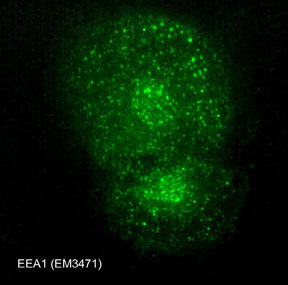Anti-Early Endosome Antigen 1 (EEA1) Antibody
- SPECIFICATION
- CITATIONS
- PROTOCOLS
- BACKGROUND

Application
| WB |
|---|---|
| Primary Accession | Q15075 |
| Reactivity | Bovine |
| Host | Mouse |
| Clonality | Mouse Monoclonal |
| Isotype | IgG1 |
| Clone Names | M347 |
| Calculated MW | 162466 Da |
| Gene ID | 8411 |
|---|---|
| Target/Specificity | Early endosomes are cellular compartments that receive endocytosed materials and sort them for vesicular transport to late endosomes and lysosomes, as well as for recycling material to the plasma membrane. Early endosome antigen 1 (EEA1) is an early endosomal protein that contains an N-terminal zinc finger motif, a cys-rich C-terminal metal-binding finger, and multiple sites for N-glycosylation, phosphorylation, and N-myristoylation. Expression of EEA1 mRNA is observed in skeletal muscle, heart, brain, lung, liver, and pancreas. Immunoblot analysis shows that EEA1 is a 180-kDa protein localized in membrane and cytosolic fractions. Immunofluorescence microscopy shows that EEA1 colocalizes with transferrin and with RAB5 in early endosomes, but not with RAB7 in late endosomes. |
| Dilution | WB~~1:1000 |
| Storage | Maintain refrigerated at 2-8°C for up to 6 months. For long term storage store at -20°C in small aliquots to prevent freeze-thaw cycles. |
| Precautions | Anti-Early Endosome Antigen 1 (EEA1) Antibody is for research use only and not for use in diagnostic or therapeutic procedures. |
| Shipping | Blue Ice |

Thousands of laboratories across the world have published research that depended on the performance of antibodies from Abcepta to advance their research. Check out links to articles that cite our products in major peer-reviewed journals, organized by research category.
info@abcepta.com, and receive a free "I Love Antibodies" mug.
Provided below are standard protocols that you may find useful for product applications.
Background
Early endosomes are cellular compartments that receive endocytosed materials and sort them for vesicular transport to late endosomes and lysosomes, as well as for recycling material to the plasma membrane. Early endosome antigen 1 (EEA1) is an early endosomal protein that contains an N-terminal zinc finger motif, a cys-rich C-terminal metal-binding finger, and multiple sites for N-glycosylation, phosphorylation, and N-myristoylation. Expression of EEA1 mRNA is observed in skeletal muscle, heart, brain, lung, liver, and pancreas. Immunoblot analysis shows that EEA1 is a 180-kDa protein localized in membrane and cytosolic fractions. Immunofluorescence microscopy shows that EEA1 colocalizes with transferrin and with RAB5 in early endosomes, but not with RAB7 in late endosomes.
If you have used an Abcepta product and would like to share how it has performed, please click on the "Submit Review" button and provide the requested information. Our staff will examine and post your review and contact you if needed.
If you have any additional inquiries please email technical services at tech@abcepta.com.













 Foundational characteristics of cancer include proliferation, angiogenesis, migration, evasion of apoptosis, and cellular immortality. Find key markers for these cellular processes and antibodies to detect them.
Foundational characteristics of cancer include proliferation, angiogenesis, migration, evasion of apoptosis, and cellular immortality. Find key markers for these cellular processes and antibodies to detect them. The SUMOplot™ Analysis Program predicts and scores sumoylation sites in your protein. SUMOylation is a post-translational modification involved in various cellular processes, such as nuclear-cytosolic transport, transcriptional regulation, apoptosis, protein stability, response to stress, and progression through the cell cycle.
The SUMOplot™ Analysis Program predicts and scores sumoylation sites in your protein. SUMOylation is a post-translational modification involved in various cellular processes, such as nuclear-cytosolic transport, transcriptional regulation, apoptosis, protein stability, response to stress, and progression through the cell cycle. The Autophagy Receptor Motif Plotter predicts and scores autophagy receptor binding sites in your protein. Identifying proteins connected to this pathway is critical to understanding the role of autophagy in physiological as well as pathological processes such as development, differentiation, neurodegenerative diseases, stress, infection, and cancer.
The Autophagy Receptor Motif Plotter predicts and scores autophagy receptor binding sites in your protein. Identifying proteins connected to this pathway is critical to understanding the role of autophagy in physiological as well as pathological processes such as development, differentiation, neurodegenerative diseases, stress, infection, and cancer.



